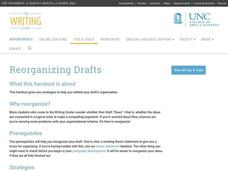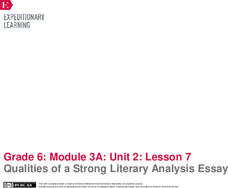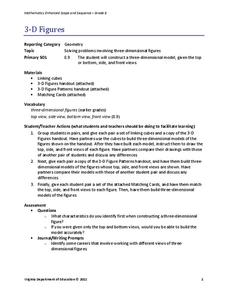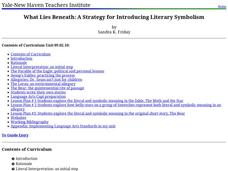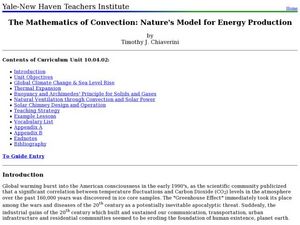Balanced Assessment
Number Game
It's all in the numbers! Create a mathematical model to analyze a number game and develop a winning strategy. Using a given numerical pattern, scholars write an expression to model the scenario. They then interpret the pattern of the...
University of North Carolina
Reorganizing Drafts
Poor organization often destroys an otherwise good paper. After writing a first draft, individuals consider the organization of ideas, a topic discussed in the 16th handout in the 24-part Writing the Paper series. The resource covers...
Curated OER
Self-Monitoring Strategies and Vocabulary Games
Middle and high schoolers identify how to discover a word's meaning by exploring context clues and any pictures, diagrams, photographs, and charts that might be included. They continue this process with other examples and locate one on...
EngageNY
Qualities of a Strong Literary Analysis Essay
Read like a writer. Scholars read a model literary analysis in preparation for a similar writing assignment before annotating each paragraph for the gist. Next, pupils devise a list of qualities of a strong literary analysis essay.
Novelinks
The Tempest: QAR
Asking questions about a text is an effective way to improve reading comprehension. Apply the Question Answer Response strategy to your unit on William Shakespeare's The Tempest. As kids read each passage, they decide if the answer...
Concord Consortium
Bill the Ball Bearing Man
Just how durable could a hollow ball bearing be? Learners model the strength of the walls of a ball bearing as a function of the radius of its cavity. They use their models to make reasonable conclusions about the probability of failure...
Virginia Department of Education
3-D Figures
Scholars construct three-dimensional figures to study dimension and side views. Learners build models using linking cubes to match views of different sides. After practicing with models, they attempt to match three-dimensional drawings...
University of North Carolina
Essay Exams
For decades, the sight of blue books has struck fear in the hearts of collegians. Those books usually signal an essay exam, the topic of one of the handouts in a larger series on specific writing assignments. Using the handout, writers...
Have Fun Teaching
Making Inferences (1)
Provide readers with an opportunity to practice drawing inferences by giving them this activity. Kids identify the text and author, record a sentence they believe infers rather than directly says, and then write the deeper meaning the...
K-5 Math Teaching Resources
Base Ten Hundreds Flats (4 per Page)
Looking for a base 10 hundreds flat? Look no further! Here, you'll find four base 10 hundreds flats with space to write under each model.
ReadWriteThink
A Picture's Worth a Thousand Words: From Image to Detailed Narrative
A picture's worth a thousand words—and even more inspiration! A visual activity uses photographs to inspire writers. The process teaches aspects of narrative writing, such as point of view and characterization.
K20 LEARN
It's All About Balance! Parallel Structure
I came, I saw, I conquered! Parallel structure, employed by writers even before Julius Caesar, is the focus of a instructional activity that teaches young writers the power of this rhetorical device. Class members analyze speeches by Dr....
Curated OER
Writing a Business Letter to Compare and Contrast
Students compose business letters. In this writing skills lesson, students use the business letter format as they note cause and effect relationships between the weight epidemic in the United States and changing menus in American...
Curated OER
QAR: Question Answer Relationships Strategy: The Catcher in the Rye
Encourage readers to think deeply about text with a reading strategy that promotes active comprehension. Individuals develop questions on four levels (right there, think and search, author and you, and on my own). Step-by-step directions...
Curated OER
Writing Summaries
Practice summary writing with informational texts. Young readers create summaries after reading magazine articles, newspaper articles, or other forms of informational texts. Readers use the GRASP strategy (read text, write what you...
Yale University
What Lies Beneath: A Strategy for Introducing Literary Symbolism
“It’s not about what it is, it’s about what it can become.” You’re never too old for Dr. Seuss and using The Sneetches and The Lorax is a great way to introduce readers to allegories, parables, and literary symbolism. The lessons...
Curated OER
The Mathematics of Convection: Nature's Model for Energy Production
High schoolers conduct a series of experiments to investigate density, buoyancy and climate. In this math lesson, pupils design and build a hot air balloon to demonstrate convection. They research and write a paper about solar chimneys.
Curated OER
Decimal Models
Before jumping into numeral decimals, explore them visually using this base 10 strategy. There is a set of examples to help scholars understand the concept. They color in grids to represent decimals written in a variety of ways. Some...
Novelinks
The House of the Scorpion: Request Strategy
Readers of The House of the Scorpion try to stump their teacher in a QAR questioning game. Pairs craft Right There, Think and Search, On Your Own, and the Author and You questions and the class members then take turns responding to...
Curated OER
Note-Taking: K.I.S.S. "Keep It Short and Simple"
Note-taking is an essential study skill, and it needs to be taught! In the context of a research project on energy sources, learners find multiple sources, evaluating, paraphrasing, and citing them correctly. Two lists with note-taking...
Curated OER
Unwind: Pre-Reading Strategy, K-W-H-L
Readers of Neal Shusterman's young adult science fiction novel, Unwind, record what they know, what they want to know, how the will find answers to the questions, on a KWHL chart.
Novelinks
The Good Earth: Biopoem Strategy
To gain a better understanding of characters in Pearl Buck's The Good Earth, kids create a biopoem for one of her characters.
Curated OER
Wildwood Dancing: K-W-H-L Reading Strategy On Prejudice
As part of a study of Juliet Marillier's Wildwood Dancing, class members create a KWHL chart listing what they know, what the want to know, how they will find information, and what they have learned about prejudice.
EngageNY
Modeling with Polynomials—An Introduction (part 1)
Maximizing resources is essential to productivity. Class members complete an activity to show how math can help in the process. Using a piece of construction paper, learners construct a box with the maximum volume. Ultimately, they...

